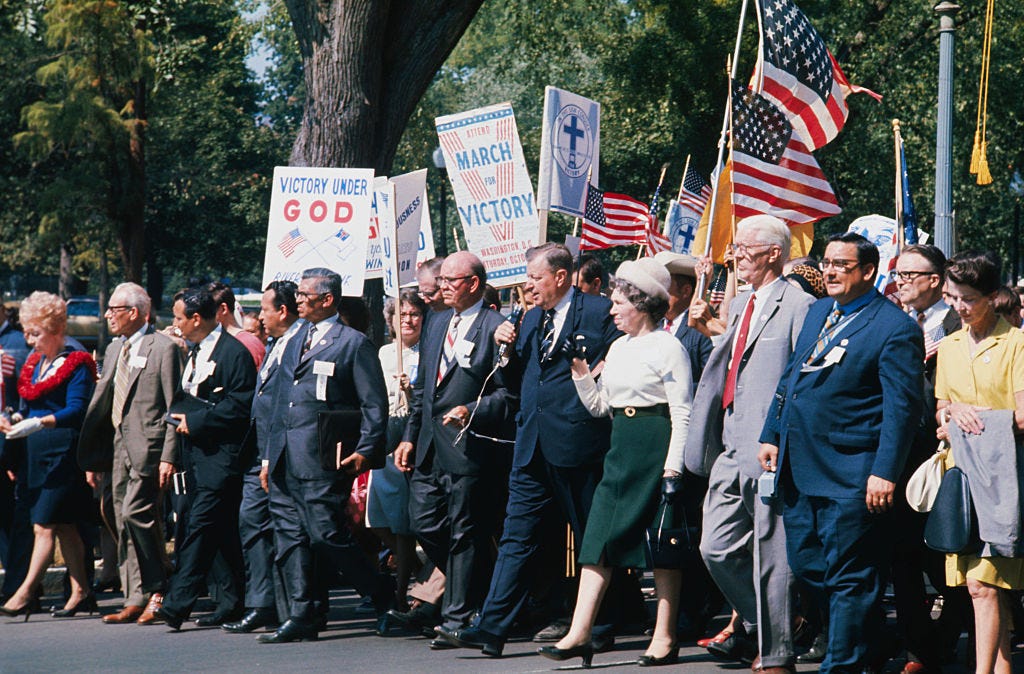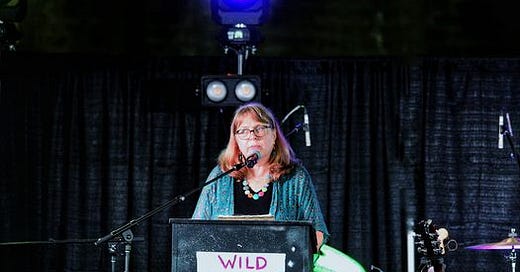

Discover more from The Cottage
Today’s post is the third in a series exploring fundamentalism from a variety of angles in light of the centennial of Harry Emerson Fosdick’s May 1922 sermon, Shall the Fundamentalists Win? The first installment can be read HERE and the second HERE.
The series continues by looking at shifting definitions of “fundamentalist” and “evangelical.” Next week, I’ll be exploring fundamentalism as a global phenomenon.
In the late 1970s, I was a student at Westmont College in Santa Barbara, California, an evangelical Christian liberal arts college. Each word was important to our community’s sense of identity. We insisted on all those terms — “evangelical” meant we weren’t fundamentalists; “Christian” put us in the long tradition of historic faith; and “liberal arts college” separated us from Bible schools.
It was especially important to distinguish ourselves from fundamentalists. No one wanted to be a fundamentalist except, of course, real fundamentalists. We joked about this:
One day, a liberal journalist showed up at Westmont and said, “I want to interview some fundamentalists.” The students said, “There are NO fundamentalists here. If you want to talk to fundamentalists, you have to go to Wheaton College in Illinois.” The journalist went to Wheaton and asked to interview some fundamentalists. The Wheaton students replied, “We’re NOT fundamentalists. There are no fundamentalists here. If you want to talk to fundamentalists, you have to go back to California and talk to students at Biola College.” So, the journalist went to Biola and asked to talk to fundamentalists. The students said, “Who told you that there are fundamentalists here? If you want to talk to fundamentalists, go to Bob Jones University in South Carolina.”
The discouraged journalist left Los Angeles and made his way to Bob Jones. When he got there, he asked the first student he saw, “I want to interview a fundamentalist. Please tell me who I can talk to.” The student looked at him and said, “Just one? We’ve got 2,000.”
Trust me. It got a lot of laughs.
Since this is the centennial of Shall the Fundamentalists Win?, is seems important to revisit the most basic question: What is a fundamentalist anyway?
“Fundamentalist” is a subset of “evangelical.” Evangelical Christianity was born in the 1740s, as a form of Protestantism that emphasized the experience of being “born again.” Evangelicalism is not a denomination (although some denominations – like the Southern Baptist Convention or the Evangelical Covenant Church – are primarily made up of evangelicals), it is essentially a cluster of beliefs and experiences through which some Protestants engage their faith. Not all Protestants are evangelicals – and instead they may be liturgical, ecumenical, confessional, or liberal.
The term, “fundamentalist” emerged to describe a particular group of evangelicals. The best definitions are the shortest and quippiest:
A fundamentalist is anyone to the right of you.
A fundamentalist is an evangelical who is mad about something.
A fundamentalist don’t drink, dance, or chew — and won’t go with anyone who do.
A fundamentalist is anybody you don’t like.
Very few people — even fewer than in the 1970s when we told that joke — want to be called fundamentalists. But the truth of the matter is that despite cultural anxiety about the moniker, fundamentalism is a stronger social and political force now than then. In effect, fundamentalism is now hiding in plain sight, under the term “evangelical” and, more broadly, just “Christian.” It has been an interesting century-long journey of a word: fundamentalist.

“Fundamentalist” didn’t start out as an insult. From 1910-1915, a series of pamphlets entitled The Fundamentals were widely distributed defending traditional Christian beliefs against emerging Protestant liberalism and new biblical criticism. In 1920, a Baptist newspaper editor referred to those Christians who held to fundamental doctrines as “fundamentalists,” a term that praised their clarity and courage to uphold the faith. The word wasn’t pejorative. It was invented as a self-descriptor by conservative Christians themselves!
But terms rarely stay the same. And “fundamentalist” is no exception. Over the last century, it has gone through four major shifts in meaning.
At its most basic level, fundamentalism is a 20th and 21st century oppositional religious movement under the larger rubic of “evangelicalism,” a historical form of Protestantism from the eighteenth century. Most scholars define it as a religious rejection of modernity and liberalism. Yet, that oppositional stance has shown different public faces at different times, depending on what adherents needed to oppose! In effect, this kind of Christianity is highly sensitive and responsive to cultural change.
There is a profound irony here. Although fundamentalists claim to be “biblical” Christians who cling to traditional faith, their self-definition and theological concerns are effectively interdependent (perhaps even codependent) with secular and liberal culture.
(Please note: This isn’t a comprehensive history. Rather, it is a brief overview of how this term changed over time.)
* * * * *
Stage One: Theology
Although I’m not sure I’ve ever read a book or article that pointed this out, American fundamentalism was birthed in the midst of the last pandemic. After having been through our pandemic, the similarities between then and now are striking.
The 1918-1920 pandemic — especially as it followed the Great War — created a combustive mix of anger at both elites and minority “outsiders,” a rejection of science and history, fear of “depraved” cosmopolitan culture, and distrust of establishment institutions (government, higher education, and mainstream denominations).
In this matrix, a theology emerged that was about safety and protection of white American Protestants: it was anti-modern and racially bound, created its own narratives of science and history (creationism and dispensationalism), emphasized purity (especially of women and white people), and wanted institutions to protect and advance their agendas (which they believed to be God’s plan for America). The theological mix held the Bible to be the inerrant and unchanging Word of God, insisted upon literalist interpretations of classical Christian doctrines, unfolded an apocalyptic view of history, and empowered a crusading rejection of evolution and biological science — all fueled by the traumas of a recent war and global pandemic.
Thus, a century ago, “fundamentalism” was primarily a theological movement that resisted Protestant liberalism and new ideas in science, society, and history. Fosdick’s Shall the Fundamentalists Win? is largely a refutation of fundamentalist doctrines – and the fundamentalist quest for doctrinal conformity within Protestant denominations.
Stage Two: Shame
In the first conflicts of the Fundamentalist-Modernist controversy, fundamentalists often won. Ministers, like Harry Emerson Fosdick, were run out of their pulpits as crusaders within denominations fought for doctrinal purity. Churches split and theological seminaries divided. Lives were ruined. Christians behaved very badly.
Eventually, however, the tide of public opinion turned against the fundamentalists – in no small measure because of the 1925 Scopes Trial in Tennessee. By 1930, fundamentalists were losing ground in their denominations and were becoming an increasingly embattled minority.
In the last installment, I made the case that fundamentalism was shaped by shame. Indeed, their interpretation of sin – that human beings are worthless and completely incapable of anything good – often slid over the theological line from human beings doing bad things to humans being bad in and of themselves. The potential for the Christian understanding of sin (something we do) to shift toward shame (something we are) has always been a theological temptation. With the emphasis that fundamentalists placed on personal sin, the need for salvation, and revivalism, misunderstanding sin as shame was ever-present.
When this doctrinal proclivity ran into public contempt (and, as the 1920s unfolded, the ridicule heaped on fundamentalists by elites and institutions was enormous), shame turned toxic for fundamentalists.
One of the first psychological responses to shame is withdrawal, to separate from the source of the shame. And that’s exactly what fundamentalists did – they abandoned the churches, schools, mission boards, publishing houses, and media that they perceived had shamed them and they built their own world of the same to protect themselves.
Writing on shame and society, Bret Lyon notes that shamed people who have withdrawn find others with the same experience to form community:
Not only is the shame, powerlessness and isolation avoided, but there is a deep sense of connection to the other shamers—a sense of belonging to a group. In this way, the sense of shame is buried in shared righteousness. We are now united, right and good, the group believes. And we live in solidarity with many other angry, disgruntled, contemptuous people. What is wrong is now on the outside, to be scorned and shamed—even mistreated.
Thus, shamed fundamentalists “went away,” unnoticed by mainstream culture. Shall the Fundamentalists Win? Nope, said mainline denominations and cultured elites who thought they’d beat back the theological barbarians at the gate.
But the fundamentalists were busy – making community, building new institutions, and casting scorn on outsiders, whom they increasingly viewed as sinful, evil, and even demonic.
For two or so decades, fundamentalists had created their own reality — a complete world — separate from the rest of us — and it was a universe where toxic shame festered. Yet there, they felt safe and were still proud to be fundamentalists.
Stage Three: Conflict Within
Following World War II, an argument developed within the fundamentalist world. Some people grew restless with intellectual and social isolation and began to argue for re-engagement with the larger world. Revivalists like Billy Graham didn’t want to preach only to the saved. Carl F.H. Henry, trained as both a journalist and a theologian, sought to address audiences beyond fundamentalism. And educators like Harold Ockenga and Francis Schaeffer created global platforms to engage sophisticated seekers.
These men were fundamentalists, most educated (at least in part) within the fundamentalist world, ordained as pastors in fundamentalist churches. Strategically, however, they grew dissatisfied and began to critique their own tribe. What good was it to possess the truth if no one except your in-group knew it? They adopted a new name for themselves – neo-evangelicals – a label that harkened back to the older term for experiential Protestantism. And, as new evangelicals, they wanted to re-enter elite culture institutions, including the media, education, and politics.
Thus, “fundamentalism” became two things:
Old-style fundamentalists who continued to insist on the theology and wanted to remain safe within the fundamentalist world; and
Neo-evangelicals who retained fundamentalist theology with little alternation but who wanted to change the secular and liberal world and bring it in line with what they believed to be God’s design for society.
Through the ministry of Billy Graham, the success of Christianity Today magazine, and the prominence of their colleges (Wheaton) and seminaries (Fuller), neo-evangelicalism became a presence in Eisenhower’s America. The fundamentalists who rebranded found surprising cultural acceptance, and yet craved even more prestige to make up for what they’d once lost. Take over Harvard? Write for the New York Times? A neo-evangelical president, perhaps?
But there were still unreconstructed fundamentalists, now doubly shamed (by both secular elites and the “bougie” neo-evangelical intellectuals within their own family). And the rebranded fundamentalists happily dropped the “neo” from their moniker — to separate themselves even further from their roots — and called themselves evangelicals. The rebranded ones didn’t want to associate with the shamed any longer. They wanted to beat their shamers at their own elite game.
The new evangelicals found out that there was shame only in the name.
Stage Four: Politics as Revenge
When Jimmy Carter, born-again Baptist, was elected president, the new evangelicals cheered. Electing an evangelical president wasn’t quite as hard as they had feared. In October 1976, shortly before the election, Christianity Today triumphantly proclaimed:
After being ignored by much of the rest of society for decades, [evangelicals] are now coming into prominence. Indeed, 1976 seems to be the year of the evangelical. No other sector of the Christian Church seems as vibrant, and certainly no other is getting as much attention.
The shamed were redeemed. By, of all things, politics. That was, perhaps, high tide of neo-evangelicalism.
Although the people at Christianity Today wouldn’t have known it, their still-separated fundamentalist cousins were in the offing, eyeing the success of the evangelical elite. And they were mad. Angry that a “liberal” like Jimmy Carter claimed to be an evangelical, mad about Civil Rights, feminism, and where abortion might lead, and mad that their more mannered – to their mind, compromised – kin were being invited to the White House.
And so, by the end of the Carter years, the fundamentalists decided they’d had enough. No more being called a “subculture” by snooty Wheaton academics. They returned with a vengeance to the public square. They rebranded, too. They called themselves the Moral Majority, and they also took back the moniker “evangelical.”
The neo-evangelicals were not amused. At their colleges and seminaries, elite evangelicals were shocked by Jerry Falwell, distrusted Pat Robertson, and embarrassed by Jim and Tammy Faye Bakker. People I knew called them bumpkins, hicks, and worse – heaping the same contempt on the new political fundamentalists that had once been used on their very own parents and grandparents. Most intellectual evangelicals thought the Moral Majority was a fad that would pass, and regularly pronounced it had overreached and had come to an end. They were always wrong.
What happened instead is that fundamentalists rebranded themselves and displaced the neo-evangelicals who had, however briefly, outshined them. And it was successful. By the time that George W. Bush was elected, Richard Mouw, the president of Fuller Seminary, openly wondered if intellectual evangelicals needed a new rebranding, suggesting the label “neo-fundamentalism” in a Christianity Today editorial. That idea went nowhere. Evangelicals who proudly traced their lineage to the 1950s rebranding of Graham, Henry, Ockenga, and Schaeffer watched helplessly – or became complicit with – the new politicized fundamentalism that stole their strategy and seized their moniker.
When Donald Trump arrived on the scene, all that they had left was to convene conferences and complain about how dangerous the fundamentalists (read: their own donors and fellow church members) were. The few evangelical resisters are now being run out of their churches or leaving willingly because they can’t stand it any more. The heirs of Graham and Henry remain huddled in a few colleges, still proclaiming that they aren’t fundamentalists, hoping the storm might pass.
They know the truth – the fundamentalists have taken over their entire movement.
And a political party and the United States Supreme Court to boot. Pretty good work for a bunch of hicks.
Shall the Fundamentalists Win? One hundred years later, the answer is yes. They have. But, whatever you do, don’t call them “fundamentalists.” They are “evangelicals.” And they aren’t ashamed of anything, except for their original label. But an angry evangelical by any other name is . . . well, still the same: a shamed fundamentalist.
And American politics is the arena of their revenge.
* * * * *
If you were wondering, Bob Jones University now refers to itself as an “Christian liberal arts university.” I’ve no idea what they’d say to a liberal journalist looking for a fundamentalist to interview. You have to dig pretty deep to even find the word “fundamentalist” on its website. Buried on an obscure page, however, you can still find this:
From its founding, BJU has been and continues to be identified with orthodox, evangelical Christianity as expressed in historic Fundamentalism. BJU’s charter and creed express the beliefs of historic fundamentalists. The history of Bob Jones University is intertwined with the history of Fundamentalism from its beginning to the present day. BJU has identified itself with the movement and has played a major role in its leadership.
Historically, Fundamentalism is a movement committed to the confession and propagation of the historic biblical doctrines essential to the Christian faith; the defense of the whole bible as the absolute, inerrant, and authoritative Word of God; the pursuit of holiness; and separation from all forms of apostasy and ungodliness.
Fundamentalism is like that — the Bob Jones website. You can rebrand, and rebrand again. But if you know where to look, just peel back a few layers, and you discover that it is still there.
By any other name . . .
Know someone who is graduating? Especially from seminary? Give them the gift of the Cottage!
INSPIRATION
Because the eye has a short shadow or
it is hard to see over heads in the crowd?
If everyone else seems smarter
but you need your own secret?
If mystery was never your friend? . . .
— Read the entire poem, “Fundamentalism,” by Naomi Shihab Nye
When this series concludes, I will be doing a live Q&A event for paid subscribers to talk about fundamentalism, evangelicalism, and the current state of American politics and religion.












Forty years ago, sitting in a church history class in a Southern Baptist seminary (before seminary taken over by the Fundamentalist), the professor said two things that I wrote down in the margins of my notes and memorized: 1) Fundamentalism with a capital F is always mean at its core. 2) Scratch down hard enough on a Fundamentalist and you will discover an atheist, because when you remove the propositions about God you eventually are left without anything to base your faith.
I have found this to be true.
I have a bachelor's degree in biblical studies from Faith Baptist Bible College, Ankeny, IA, another bastion of fundamentalism. Like BJU buried on a PDF is this: The Board of Directors of Faith has affirmed the historical position of the school as our continuing commitment. It is our earnest desire to maintain our historical purpose and tradition and to continue to train students to be leaders in fundamentalist Christianity. We intend to stand for the great principles of Bible-believing Christianity, our separatist Baptist heritage, and the authority of the inerrant Word of God. While many educational institutions are softening their stand and broadening their fellowship to be more inclusive, we intend to militantly honor Christ and the purity of the Church, even if we must do so independently.
I now cringe at the thought I was proud of this stance. My stomach turns at what this now means in current cultural context. I thank God I was delivered from this hateful, discriminatory, and unloving mindset.